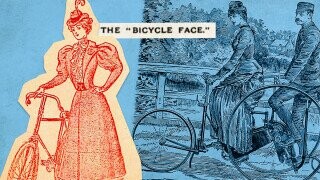When Men Thought Bicycles Would Make Women Ugly and Slutty

Bicycles are such apparently simple contraptions that it seems kind of dumb that it took us so long to come up with them. You’d think the next step after the invention of the wheel would be “let’s see what happens when we put two of ‘em together,” but bikes are actually complicated pieces of machinery, and we’re still not entirely sure how they work. Luckily, they were perfected in the late 19th century, a time when not knowing how things worked never stopped anybody. It also happened to coincide with a period when upper-class white women accomplished a lot for the rights of other upper-class white women — and just kidding, that’s not a coincidence at all.
At that point, most people still relied on horse-drawn carriages to get around, and much like a two-bedroom apartment in a nice neighborhood and her extended family’s respect today, that wasn’t usually something a woman could just own by herself. They were expensive, and because the past made no sense, if a woman had a job back then, it meant she was poor. The horses were the men’s property, and women were only barely not their property, so taking the horses out without permission was like your preteen child taking your car to Tijuana. But bicycles were relatively cheap, so for a lot of fancy ladies, it was the first time in recent memory that no one could physically stop them from going farther than the neighbor’s house.
Of course, the men in power immediately decided that if women were allowed to go wherever they wanted, where they would go was “up and down on a lot of boners,” so they did everything they could to undermine the bicycle craze, starting with the clothes. It’s really hard to ride a bike in a petticoat, so cycling women began favoring “rational clothes,” including bloomers (or “divided skirts,” as they were sold) and “sport corsets,” because suggesting that Victorian women just not wear corsets could get you burned as a witch.
Don't Miss
If you saw a dude dressed like that, you’d kindly direct him to the historical reenactment drag show, but it was decried as somehow both masculinizing and trampy and generally everything wrong with society. It was the “blue hair and tattoos” of the Victorian era. Entire formal societies sprang up with the intention of growing into a “national anti-bloomer brigade,” consisting of men who “refused to associate with any woman who wore bloomers.” To be fair, you could get wealthy white men to form a society around just about anything back then, but the whole thing blew up into a downright medical concern, with doctors at one medical convention in 1895 declaring bloomers an “abomination,” though modern historians note in a pan as dead as Teflon that “no medical reason was cited.” Sometimes, doctors just say stuff because they know we listen to them.
That’s not to say they didn’t try to come up with medical reasons cycling would make women ugly and slutty, the funniest of which was “bicycle face.” Doctors warned that their little girl bodies were no match for the “overexertion, the upright position on the wheel and the unconscious effort to maintain one’s balance” of cycling, resulting in withered lips, under-eye circles and a constant “expression of weariness,” all of which are more likely the result of living in Victorian times. They also claimed that cycling could cause everything from appendicitis to goiters and exposure to the elements “may suppress or render irregular and fearfully painful the menses.” It just so happened that the key to a happy uterus was “staying home and washing my socks.”
But the real problem, medically and otherwise, was that bicycle seats touched ladies’ no-no bads, and anything that does that runs the risk of making them horny, or worse, horny and then not horny anymore. Leaving aside the adorable ignorance of the clitoral orgasm this displays, everyone knows that once you experience one, you start rubbing your crotch on everything you see, and before you know it, we’ve all starved to death. Manufacturers went so far as to build bicycles that could be (theoretically, at least) ridden side-saddle and seats with holes in them at the potentially offending location, which worked about as well as you’d expect. What it all came down to is that men were really, really scared that women would like their bikes more than them.
So how did all of this get resolved? It didn’t, really. Although no less a luminary than Susan B. Anthony once said that bicycles had “done more to emancipate women than anything else in the world,” the cycling craze of the turn of the century was extremely short-lived.
Soon enough, cars happened, and rich white ladies thought they were just as bitchin’ as everyone else and ditched their bikes — for the same reasons most of us stopped riding bikes when we were 16. Obviously, cars have all the downsides that bikes don’t — they were and still are much more expensive, and to this day, car culture is stupidly gendered — but, well, air-conditioning is its own kind of liberation, isn’t it?